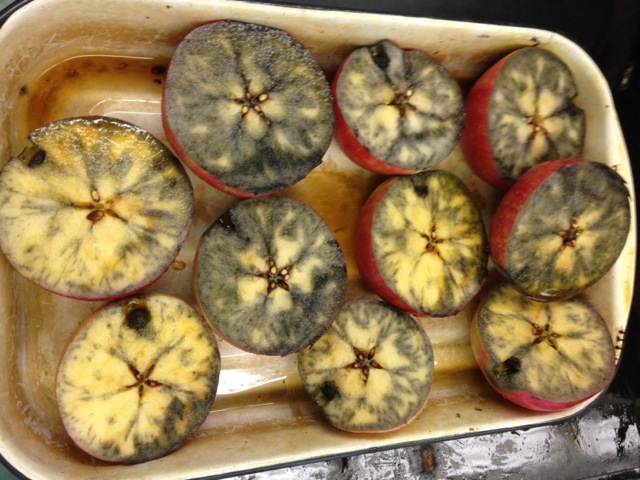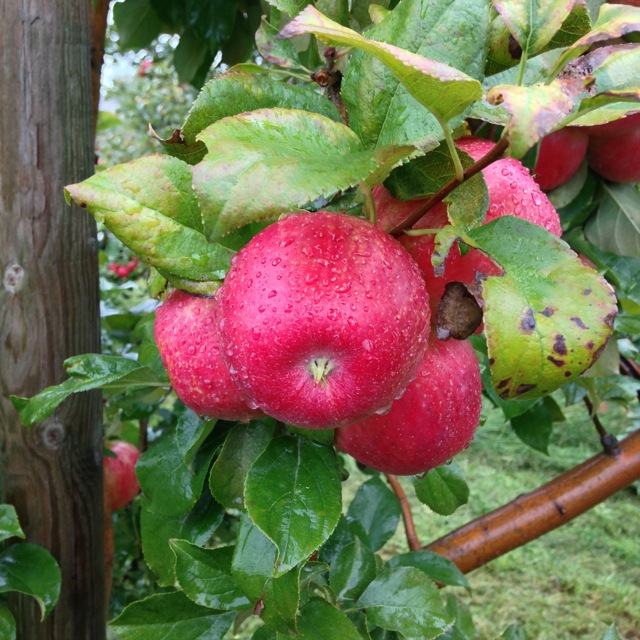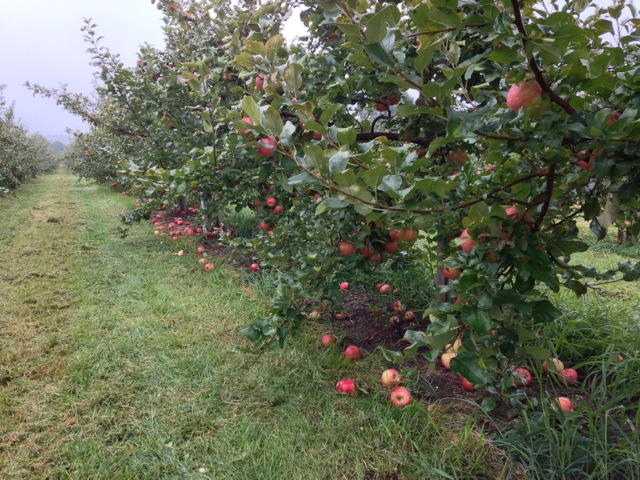

Some observations on Honeycrisp maturity
Getting the most from that "old" stop drop: NAA
Pre-harvest drop has started to kick-in on McIntosh and Honecyrisp, particularly fruit that was not treated with ReTain. Now would be a good time to review the article "Getting the Most From The "Old" Stop-Drop: NAA" re-printed below from a previous Healthy Fruit. Otherwise, color development has been good with the cool weather, and McIntosh harvest should begin in earnest now as predicted earlier. Keep picking...JC
JC
Apple fruit maturity report for September 5-10, 2013
Note: most all observations from UMass Cold Spring Orchard (unless otherwise noted), Belchertown, MA and prepared by Jon Clements
| Date | Variety | Drop |
Diameter (inches) |
% Red Color |
Firmness (lbs.) |
Brix |
Starch Index |
Comments |
| 9/5 | Honeycrisp (Northboro, MA) | nil |
3.4 |
60 |
15.7 |
12.7 |
5.5 (4-7) |
ready for 1st pick, good sugar |
| 9/5 | Honeycrisp (Harvard, MA) |
nil |
3.2 |
55 |
14.7 |
11.3 |
6 (4-8) |
probably ready for 1st pick |
| 9/5 | Honeycrisp (Stow, MA) |
nil |
3.2 |
45 |
16.8 |
10.9 |
5 (3.5-7) |
most likely treated with ReTain |
| 9/9 | Snappy Mac | few |
3.0 |
75 |
17 |
11.4 |
4.1 (4-5) |
seeds dark; right on track for first pick as predicted; nice red color on these Snappy Mac |
| 9/10 | Lindamac | some |
3.0 |
80 |
15.7 |
11.6 |
4 (3-5) |
Lindamac is a high red color strain, similar to a good color Redmax McIntosh |
| 9/9 | Buckeye Gala | nil |
2.8 |
95 |
20 |
9.9 |
2.8 (1-4) |
marginally ready for 1st pick based on background color change (which is hard to discern on these red apples); sugars not there, but heavy crop load has adverse effect on quality |
| 9/10 | Honeycrisp | few |
3.1 |
60 |
15.7 |
11.4 |
6 (4-8) |
note the higher starch-index on these Honeycrisp from over-cropped Bud. 9 comapred to the B.118 below; probably never had much starch to begin with, and will not develop enough sugar and varietal flavor |
| 9/9 | Honeycrisp | few |
3.4 |
65 |
14.7 |
11.2 |
4.6 (3-6.5) |
sugars not developed fully, but ready for first pick; ripe fruit starting to drop; these Honeycrisp on B.118 rootstock are nice fruit |
| 9/10 | Blondee® | none |
3.0 |
5 |
18 |
11.6 |
4.5 (3-7) |
Blondee is the finest yellow apple I know in this season, it's like a yellow Gala |
| 9/10 | RiverBelle® (DS-22 cv.) |
nil |
3.6 |
70 |
16.8 |
13.9 |
5.5 (3-7) |
RiverBelle® is a new, regional apple variety being planted in MN and WI; it is a large, sweet apple designed for the regional market, but available to anyone who wants to plant; it most likely has a Honeycrisp parent; large fruit, some russet/fruit finish issues |
Jon Clements
I have come to the conclusion that in terms of fruit ripening and maturity, Honeycrisp is like your local pizza shop -- everyone makes a differennt pizza and every Honeycrisp is different. (As opposed to Gala or McIntosh being like Dominos pizza, pretty much every pizza is the same.) This makes picking Honeycrisp at the appropriate maturity and highest quality very difficult. Honeycrisp quality is very sensitive to crop load too, fruit from over-cropped trees being substantially poorer in quality -- and differing in starch iodine index -- than those from moderately cropped. Therefore, note the following:
Good luck in getting Honeycrisp picked and marketed in 2013, there is a large crop of Honeycrisp (and all apples) out there.
 |
 |
Honeycrisp starch iodine (SI) index from over-cropped Bud. 9 trees, SI index = average 6, range 4-8 |
Honeycrisp starch iodine (SI) index from moderately cropped Bud.118 trees, SI index = average 4.6, range 3-6.5 |
 |
 |
Honeycrisp apples on ReTain treated trees |
Honeycrisp apples with no ReTain |
by Jim Schupp, PhD.
Specialist in Pomology, Penn State University
Reprinted from Scaffolds Fruit Journal
August 18, 2003 Volume 12 No. 23
http://www.nysaes.cornell.edu/ent/scaffolds/
Edits by Win Cowgill, County Agricultural Agent NJAES, and again reprinted from Rutgers Cooperative Extension Plant & Pest Advisory, Fruit Edition, August 19, 2008
The use of NAA (Fruitone L) for control of preharvest drop has been overshadowed in recent years by that of ReTain; however, ReTain use must be planned weeks prior to harvest. With the effective application time so close to the onset of drop, NAA offers a "rescue" treatment, should the threat of preharvest drop be increased due to unforeseen circumstances. Examples of such situations include unavoidable delays in harvest due to bad weather or labor issues, slow red color development, and overlapping harvest schedules of varieties with similar maturity windows, such as McIntosh with Macoun, or Empire with Delicious. While it is not the purpose of this article either to promote or condemn the use of ethephon (Ethrel, Ethephon II) to promote fruit coloring, those growers using one of these products also need to use NAA to prevent excessive fruit drop resulting from accelerated fruit maturation. The following tips and reminders are offered to help growers brush up on using NAA to best effect.
Timing NAA stop-drop sprays is a little like a game of chicken, requiring both steely nerves and a good understanding of your opponent. The label says to apply NAA when the first sound fruit begin to drop. A single spray of 10—20 ppm NAA offers drop control for about seven days from the date of application, but it takes two or three days to "kick in". Apply NAA three days too early and the window of effective drop control is about halved. Apply three days too late and perhaps a quarter of the crop will be on the ground before the NAA takes effect!
Stem loosening coincides with the climacteric rise in ethylene that signals fruit ripening. Unlike ReTain, which delays drop by delaying fruit maturation, NAA stops drop by delaying stem loosening.
Varieties such as McIntosh that are highly susceptible to preharvest drop require careful monitoring to determine when fruit drop is beginning. Limb tapping should be used to determine the onset of drop as fruit near maturity. Bump several scaffold limbs of three or four inches in diameter throughout the block on a daily basis. Use the palm of your hand with a short firm stroke, striking the limb at its mid-point (just like golf, this skill improves with practice and experience). If zero to one apples per limb drop on average, it's too soon to apply NAA. If the average is about two, check again later the same day or the next morning. When several apples drop in response to limb bumping, its time to harvest within two days or apply NAA.
When NAA is used to control drop on ethephon-treated trees, the two may be tank-mixed if the fruit is to be harvested within seven days. If the fruit is to be left on the tree longer than seven days after the ethephon, then NAA should be applied three days after the ethephon.
Rates of 10—20 ppm NAA are usually needed to be an effective stop-drop. To obtain the maximum drop control, use a split application of 10 ppm in the first spray, followed by a second spray of 10 ppm five days after the first. Split applications can provide drop control for about 12 days from the date of the first application.
As with thinning sprays, stop-drop sprays of NAA work best when applied with good coverage and plenty of water. Concentrating beyond 4X (less than 75 gallons of water per acre for 300 gallon TRV trees) may diminish the effectiveness. Use a non-ionic or organosilicone surfactant to enhance uptake.
When used as a stop-drop, NAA may advance ripening, especially at the maximum label rate of 20 ppm. The primary impact of his advance in maturity is reduced storage potential of the fruit, particularly in the loss of firmness. This effect is not consistent from year to year or block to block. The question then arises whether NAA-treated fruit has potential for CA storage or treatment with SmartFresh (1-MCP).
(Editors Note: this loss of firmness is not an issue on PYO blocks or fruit held for short term storage.)
ReTain and NAA - Finally, a comment about use of NAA on trees previously treated with ReTain. The use of both stop-drops at the respective correct times results in drop control that is superior to that obtained by using either one alone. Fruit treated in this manner, then left for an extended time on the tree, often have limited storage potential (see above); however, this combination can be an effective way of getting the ultimate in drop control. This drop control combination program should be used on high value fruit with little or no storage period, such as for a few rows of trees held for late picking in PYO blocks or on McIntosh that Retain alone may not be as effective as we like.
ReTain -If you missed your ReTain application timing of 4 weeks before anticipated harvest you can still apply Retain up to 7 days PHI. This will hold the second and later pickings on the tree. You may need to use NAA as well to hold the first ripening fruits on the tree. Consult the label for more details.
 |
 |
Honeycrisp drop (09/10/13) no ReTain |
Honeycrisp drop (09/10/13) with ReTain |
UMass Fruit Advisor: http://umassfruit.com
UMass Fruit Notes: http:umassfruitnotes.com
Scaffolds Fruit Journal: http://www.nysaes.cornell.edu/ent/scafolds/
Network for Environment and Weather Applications (NEWA): http://newa.cornell.edu
Follow me on Twitter (http://twitter.com/jmcextman) and Facebook (http://www.facebook.com/jmcextman)
UMass Vegetable & Fruit IPM Network (on Facebook, http://www.facebook.com/umassipmteam)
2013 New England Tree Fruit Management Guide (http://fruit.umext.umass.edu/2013netfmg/)
The next Healthy Fruit (maturity report) will be published on Tuesday, September 17 or thereabouts, 2013. As always feel free to get in touch with any member of the UMass Fruit Team (http://extension.umass.edu/fruitadvisor/team-members) if you have questions or comments.